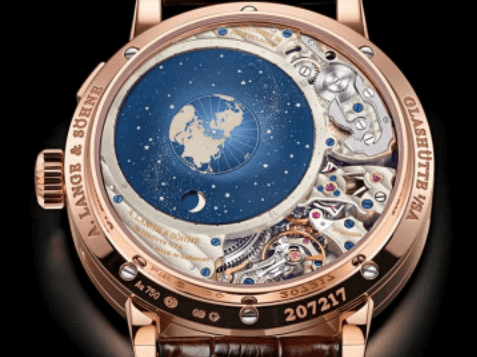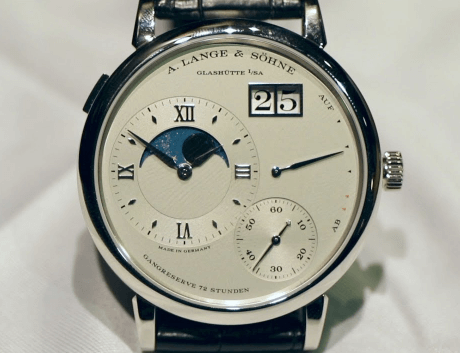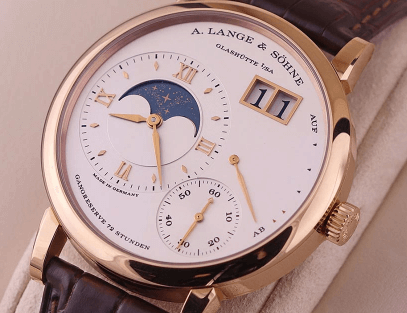A lot of time and effort goes into creating a moon phase watch. They use yellow or white gold, diamonds, gems, sapphire crystals, and intricate, high-quality parts for their inner workings. Because it takes time and materials to make a moon phase watch, the price range of these watches is costly.
Table of Contents
What is a moon phase watch?
Moon phase watches are part of a complication. This watch shows the evolution of the lunar cycle of 29 days, 12 hours, and 44 minutes through the mechanism. A rather tricky time to count, especially 44 minutes, resulting in the most straightforward moon phase mechanism missing a day every two and a half years. But it’s reasonable, so not enough to complain about.

Early machines of this type were astronomical instruments used to calculate the movements of planets and their relative positions in space, dating long before the clock was invented.
One of the first mechanisms of this type we can find is the Antikhitera, a Greek astronomical instrument from around 200 BC, whose fragments were found in the wreckage of a ship that sank in the Aegean Sea.
Most annual and perpetual calendar watches with moon phase displays today are great additions to watch collections due to their stylish character and impressive appearance. Watch enthusiasts are eager to get at least one and add it to their lineup.
How does a moon phase watch work?
One of the earliest clock mechanisms developed, a moon phase complication usually involves the placement of two twin moons on a disk beneath the dial.

Controlling the movement of the disc is a 59-tooth drive wheel that uses mechanical fingers to advance the disc once a day. A second moon appears in the hole after a single lunar cycle of 29.5 days, giving 59 teeth (29.5 x 2).
How does the moon phase dial work?
The most common display of the moon phase mechanism is the so-called “chest.” In other words, it is a disk that rotates inside a shaped window, depending on its position, which partially hides the moon’s shape, allowing the wearer to check his condition step.
In addition to this particular mechanism, other methods of marking the moon’s phases have become widespread and, in some cases, innovative and almost poetic. Nevertheless, the chest system is undoubtedly the most popular, as it is perfect as the main decorative element of a watch face.
Also, rotating disks depicting the moon and the starry sky are often made of precious metals and ornately decorated.
Is moon phase watches accurate?
Most of our moon phase displays are 99.998% accurate, so if your watch runs uninterrupted, you only need to correct one day after 122.6 years. This is achieved with an ingenious mechanical transmission that lowers the rotation of the hour wheel.
Why is moon phase watches so expensive?
Any complication of adding new functions to the watch makes the mechanism more complex and, therefore, more expensive. For example, an annual or perpetual calendar usually accompanies a typical moon phase complication. It’s easy to understand why watches that offer this poetic feature are traditionally more expensive than simple watches.

Luxury complications such as the moon phase do a lot to give the watch an exclusive aura that catches the eye of the watcher thanks to its luxurious, glamorous, discreet, and timeless beauty.
FAQ
What is the purpose of a moon phase watch?
A moon phase clock displays the solar portion of the moon as seen from Earth at a specific point during the 29.5 lunar days. It is the time it takes to go from an invisible new moon to a full moon and back again.
Why does my watch have a moon phase?
The watch is equipped with this beautiful complication mainly for historical and aesthetic reasons. Historically, lunar phases have been used in astronomical clocks. Recurring appearances in modern eyes are a tribute to the technical wisdom of all watchmakers who perfected their knowledge to achieve these refined results.
Apart from the poetic depicted, the moon phase display reveals an essential visual element that draws attention to the dial. It’s like what happens in a tourbillon.
And it’s used creatively to achieve specific results, especially with a classic look. This watch resembles a clown’s face with its moon phase display turning its tongue into its mouth.
Alternatively, as in some chronograph watches from Davosa, such as the Newton Pilot Moonphase Chronograph, the moon-phase display is enriched by the already complete and sporty dial display.
Who invented the Moonphase watch?
Dutch watchmaker Christian Van Der Klaauw has been designing an accurate moon phase complication for 11,000 years. Even more impressively, Swiss watchmaker Andreas Strehler has been developing the precise moon phase complication for over two million years.
Conclusion
Moon watches are the best choice because they take years of manual work, require intricate details and high-quality materials, and are composed of gold, diamonds, and other ethically sourced gemstones. Most brands that make moon watches are luxury and more expensive.



